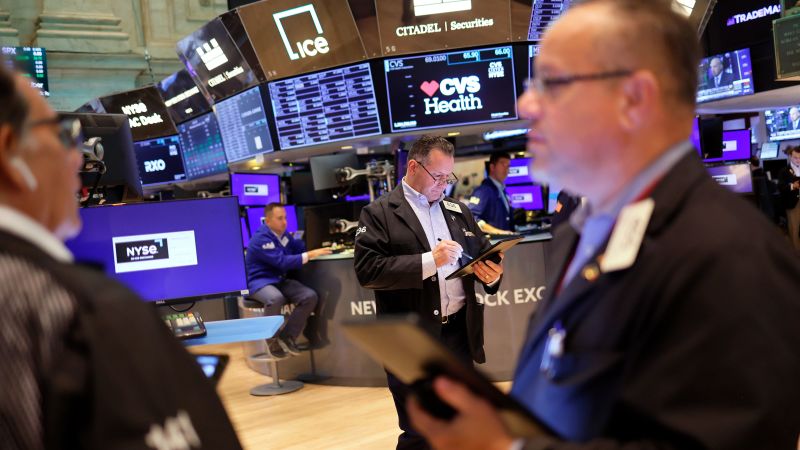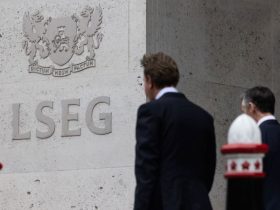A version of this story first appeared in CNN Business’ Before the Bell newsletter. Not a subscriber? You can sign up right here. You can listen to an audio version of the newsletter by clicking the same link.
Investors seem to believe that the Federal Reserve is done raising rates after it paused for the second consecutive time at its meeting on Wednesday.
But declines in small-cap stocks suggest that worries about the US economy’s health still linger on Wall Street.
The Russell 2000 index, which tracks the performance of US small-cap stocks, last Friday touched its lowest level since November 2020 after turning negative for the year earlier in October. The index is down 5% for the year, underperforming the benchmark S&P 500 index’s 10% gain.
Small-cap stocks rose during the spring, helping broaden the market’s rally beyond just Big Tech heavyweights and raising hopes among investors that the then-burgeoning bull market had staying power. A bulk of small-caps are financial stocks, whose recovery some view as key for a sustained rally. Strong banks uphold a strong economy and stock market, the wisdom goes.
But the stock rally fizzled out mid-summer, and has struggled to find footing since. The Israel-Hamas war led investors to seek out havens like gold, while surging bond yields have made holding cash the most attractive it’s looked in years.
That decline reflects pessimism about the economy’s health, as investors grapple with elevated interest rates and geopolitical strife, says Jim Polk, head of equity investments at Homestead Funds.
While the labor market and broader economy have stayed remarkably resilient since the Fed began its aggressive inflation-fighting campaign, some economists and investors warn that the economy has yet to feel the brunt of the central bank’s monetary policy tightening, which has brought the benchmark lending rate to its highest level in more than 22 years.
Small-cap stocks tend to be an indicator of economic strength, because they generate most of their revenue domestically. Smaller companies are also more sensitive to rising interest rates, which make it harder to access capital, and rising costs for line items like labor. The concern is that as tough economic conditions eat away at smaller companies’ balance sheets, they will eventually catch up to larger companies.
“It will be probably difficult for the Russell [index] to rally or show any leadership in that type of environment,” said Mona Mahajan, senior investment strategist at Edward Jones.
The Fed on Wednesday kept future rate hikes on the table, citing persistent inflation that’s yet to fall to the central bank’s 2% target. Fed Chair Jerome Powell also said that Fed officials have yet to even consider cutting rates.
Still, Mahajan says that small-cap stocks could be set up for a rally, especially if the economy sees renewed growth next year.
History shows that small-cap stocks tend to gain following broader market downturns: The iShares Russell 2000 exchange-traded fund has outperformed the S&P 500 for the two years following four out of six bear markets from 2007 to 2020, according to Penn Capital Management data.
Polk sees opportunities in beaten-down energy and financial stocks. His firm manages a small-cap fund with investments in both sectors.
Still, small-caps are “certainly not a buy, buy, buy,” said Polk.
The Federal Reserve held interest rates steady Wednesday for the second consecutive meeting, leaving the central bank’s benchmark lending rate at its highest level in 22 years, reports my colleague Bryan Mena.
Economists and financial markets had expected the pause in the Fed’s aggressive rate-hiking campaign, after several Fed officials signaled they anticipate a further slowing of the US economy as it continues to absorb the effects of higher borrowing costs.
The Fed’s post-meeting statement noted that “economic activity expanded at a strong pace in the third quarter” — a recent development that has puzzled some economists.
Despite the Fed aggressively raising interest rates 11 times since March 2022 in a bid to combat inflation, the US economy has not only avoided a recession so far, but instead expanded at a blistering 4.9% annualized rate in the third quarter, mostly due to solid consumer spending.
Read more here.
Something wild has happened with turkey prices that’s going to make the cost of cooking the Thanksgiving meal more palatable to families on a tight budget, reports my colleague Parija Kavilanz.
“There’s been a big collapse in retail prices for turkey,” said Michael Swanson, chief agriculture economist with Wells Fargo Agri-Food Institute.
“Because turkey prices are down so much, and that’s the centerpiece of the meal, celebrating Thanksgiving at home will be more advantageous this year for families,” he said.
Store prices for the 10-to 15-pound turkey, typically the star of the holiday dinner, have dropped 13% in October compared to the same month last year, said Swanson.
The decrease in shelf prices for the bird also coincides with an even more dramatic 29% slump in the wholesale price for turkey this October versus a year ago, according to Wells Fargo’s new Thanksgiving food report, which was released Wednesday.
Read more here.
Read the full article here













Leave a Reply